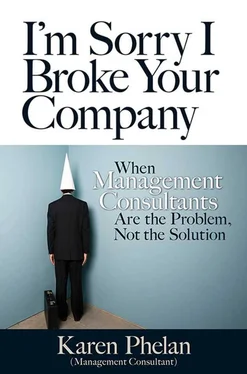Karen Phelan - I'm Sorry I broke Your Company
Здесь есть возможность читать онлайн «Karen Phelan - I'm Sorry I broke Your Company» весь текст электронной книги совершенно бесплатно (целиком полную версию без сокращений). В некоторых случаях можно слушать аудио, скачать через торрент в формате fb2 и присутствует краткое содержание. Город: San Francisco, Год выпуска: 2013, ISBN: 2013, Издательство: Berrett-Koehler Publishers, Жанр: management, popular_business, на английском языке. Описание произведения, (предисловие) а так же отзывы посетителей доступны на портале библиотеки ЛибКат.
- Название:I'm Sorry I broke Your Company
- Автор:
- Издательство:Berrett-Koehler Publishers
- Жанр:
- Год:2013
- Город:San Francisco
- ISBN:978-1-60994-740-8; 978-1-60994-741-5
- Рейтинг книги:3 / 5. Голосов: 1
-
Избранное:Добавить в избранное
- Отзывы:
-
Ваша оценка:
- 60
- 1
- 2
- 3
- 4
- 5
I'm Sorry I broke Your Company: краткое содержание, описание и аннотация
Предлагаем к чтению аннотацию, описание, краткое содержание или предисловие (зависит от того, что написал сам автор книги «I'm Sorry I broke Your Company»). Если вы не нашли необходимую информацию о книге — напишите в комментариях, мы постараемся отыскать её.
I'm Sorry I broke Your Company — читать онлайн бесплатно полную книгу (весь текст) целиком
Ниже представлен текст книги, разбитый по страницам. Система сохранения места последней прочитанной страницы, позволяет с удобством читать онлайн бесплатно книгу «I'm Sorry I broke Your Company», без необходимости каждый раз заново искать на чём Вы остановились. Поставьте закладку, и сможете в любой момент перейти на страницу, на которой закончили чтение.
Интервал:
Закладка:
Over the next few years, I spent most of my time improving operations at small manufacturers using some of the methods that were popular then: bottleneck analysis using Eliyahu Goldratt's theory of constraints, just-in-time (JIT) manufacturing practices from Japan, or MRPII (manufacturing resource planning, the precursor to ERP, or enterprise resource planning) information systems. The funny thing is, none of these methods ever worked perfectly. We always had to adapt. Often manufacturers had multiple bottlenecks that needed to be addressed together rather than one by one. While some JIT principles can be applied, the reality is that you cant implement pure JIT in this country. Japan is a small country where the suppliers are never that far away. It makes no sense in the United States to try to turn all your inventory in one or two days when it takes two weeks to get raw materials. The same thing was true about implementing manufacturing software. We would never just go in and install software. We always made sure that the processes and information were correct first. Otherwise, you would have a disaster. Even then, the initial implementation usually uncovered more bad data. Based on my experiences, I thought of these methods as guidelines or tools to be used at ones discretion — the more tools you knew, the better equipped you could be.
At the time, quality initiatives were popular, and I decided to pursue a certification in statistical process control (SPC). Manufacturing automation was becoming sophisticated enough to monitor the multitude of variables in a manufacturing process such as temperature, pressure, and speed. The idea was to monitor all these variables to determine what specifications would ensure the quality of the product. Using performance histories and statistics, you could predict when a machine would likely go out of specification or if a problem was due to operator error. It was an incredible boon to manufacturing quality and productivity. SPC supplied the underpinnings of the Six Sigma movement.
The Six Sigma movement began at Motorola in the mid-1980s when the CEO and a team of engineers realized that their product quality was terrible, and they needed to drastically improve to compete with the Japanese. «Six Sigma» is a statistical reference meaning six standard deviations from the process norm. For high quality, process variations from the desired specification need to be at the six sigma range. Six sigma means only 3.4 defects per million. Typically, people think that 99 percent accuracy is good. However, this means that for every one hundred parts you make, you have one that is defective — not a high quality process. Motorola made huge strides in improving quality and reducing costs using Six Sigma, and both GE and Allied Signal jumped on the Six Sigma bandwagon and mandated it throughout their organizations. Of course, during Jack Welch’s tenure, any program at GE was considered a business best practice and adopted wholesale throughout the business community. This time period also saw the rise of «business process reengineering.» The term is credited to Michael Hammer, who with James Champy wrote a book called Reengineering the Corporation , which became a business best seller. They defined process reengineering as «the fundamental rethinking and radical redesign of business processes to achieve dramatic improvements in critical contemporary measures of performance such as cost, quality, services, and speed.» Soon everyone wanted process reengineering.
I joined Gemini Consulting during this process reengineering heyday. One of the unique features of Gemini’s history was that It's methods were based on the work of behavioral psychologists. On each of our engagements we spent a great deal of time on «soft skills,» working with our clients on how to build teams, provide coaching and feedback, and run effective meetings. Each consultant was required to learn several of what many of us number-crunchers called «touchy-feely» techniques, including a team brainstorming method, an emotional cycle-of-change model, meeting facilitation interventions, and a process reengineering tool called «brown papers.» Brown papers were called that because we prepared high-level process flowcharts of the existing processes on a large roll of brown butcher paper. Then we invited all those involved in the business process to add their comments on the process using sticky notes and to elaborate on what was broken. These sessions were incredibly cathartic. We billed the method as «high touch and low tech.»
This method was in stark contrast to the Six Sigma statistical basis, and being an engineer by education, I was skeptical. However, the brown papers were effective. Many of the people commenting on the papers worked in different functional areas and never had the opportunity to talk about what was broken. I found that people needed to vent before they could move on, and venting via sticky notes allowed them to air their worst vitriol without getting personal. It was the process that was broken, not the people working it. There was huge value in getting all those people in a room to discuss why they did what they did, how it impacted people elsewhere, and generally understand the problems that others faced. People walked out of the sessions with a much bigger and more human perspective of the process. There was now a face to the hated customer service representative who had to deal with frustrated customers all day long, and there was a person behind the incompetent inventory manager who had the impossible job of working with constantly outdated information. This venting and humanizing process was the first step to getting the team to work together to create something better. Although we usually had assistants create electronic versions of the brown papers to give the clients for reference, I never used them. The flowcharts weren't the product; the comments were.
After this catharsis, the next step was to get many of the same people in the room and work on the «To Be» process. I was always uncomfortable with this step because it consisted of starting with a blank piece of paper and brainstorming and questioning how to be better. Gemini always required multiple consultants at these types of meetings because you needed someone to expertly facilitate the group and someone to challenge the level of thinking — a process person and a content person. I was the kind of consultant who always liked to have the answer in my pocket, even if I didn't share it, but the point of this method was to start with a blank slate. Even though I was uncomfortable with it, it always worked. Once, I tried using a structured approach based on desired outcomes, but we found it inhibited our thinking and scrapped it after thirty minutes. Somehow the teams always created a new and improved process. Sometimes it was radically different and sometimes not so much, but whenever we left the client after implementing the new process, we always left a team of people who had formed good relationships and whose job responsibilities included continuous improvement. This simple method was incredibly effective, and Gemini became well-known for process reengineering. We were even on the cover of BusinessWeek .
As we became more successful and the economy dipped into a severe recession, our engagements became larger, and we started our pursuit of business transformation. In our rapid growth phase, our leadership also pushed for more intellectual property, and thought leadership became one of our rated competencies. We wanted to compete with the likes of McKinsey, and to do so, we would need to become more analytical and systematic in our approach. Other companies were developing proprietary methods and tools and using automation, and we looked like amateurs with our brown papers. We started to develop comprehensive methodologies in all our service areas as part of the business transformation strategy. At the same time, we changed the type of people we were recruiting. One of Gemini's differentiators was that our consultants came from diverse backgrounds, and many came from the industry. Now we were hiring straight out of brand-name business schools like our competitors. We started moving away from the touchy-feely approaches to more analytical tools.
Читать дальшеИнтервал:
Закладка:
Похожие книги на «I'm Sorry I broke Your Company»
Представляем Вашему вниманию похожие книги на «I'm Sorry I broke Your Company» списком для выбора. Мы отобрали схожую по названию и смыслу литературу в надежде предоставить читателям больше вариантов отыскать новые, интересные, ещё непрочитанные произведения.
Обсуждение, отзывы о книге «I'm Sorry I broke Your Company» и просто собственные мнения читателей. Оставьте ваши комментарии, напишите, что Вы думаете о произведении, его смысле или главных героях. Укажите что конкретно понравилось, а что нет, и почему Вы так считаете.












